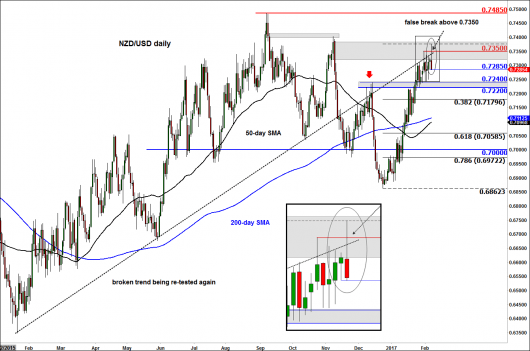NZD USD USD resumes reign as NZD slumps on Wheeler
The US dollar has extended its bounce that began at around the start of the month as the Dollar Index’s stay beneath 100 proved to […]
The US dollar has extended its bounce that began at around the start of the month as the Dollar Index’s stay beneath 100 proved to […]
The US dollar has extended its bounce that began at around the start of the month as the Dollar Index’s stay beneath 100 proved to be temporary. Consequently, the EUR/USD, GBP/USD and basically everything else against the dollar has fallen sharply today. However, the dollar’s strength is not apparent so much against the perceived safe haven gold, silver and yen. Still, it does look like that, after careful consideration, the market has decided that the dollar should resume its reign as the King of FX. Perhaps it was that strong 227K rise in headline employment for the month of January that triggered this latest bounce in the dollar as it reinforces the view that there will be at least a couple of interest rate rises coming up this year thanks to an improving economy. Elsewhere, central banks have re-iterated their dovish rhetoric, not least the European Central Bank and Reserve Bank of Australia. The Reserve Bank of New Zealand could be next.
Ahead of the RBNZ’s monetary policy decision on Wednesday night (Thursday morning NZ time), it looks like the NZD/USD may have topped out. Today’s sell-off has been triggered in part by news that the RBNZ’s Governor Graeme Wheeler will step down when his term ends in September. Deputy Governor Grant Spencer will replace him for six months after his departure until a permanent successor is appointed in 2018. With the NZ general election coming up at the end of September, the next government will have plenty of time “to make a decision on the appointment of a permanent governor,” according to Finance Minister Steven Joyce.
What this probably means in terms of monetary policy is that neither Wheeler nor Spencer – as a caretaker – will probably make any changes to interest rates now, unless something dramatically happens in the economy. Thus, the monetary policy will most likely remain extreme accommodative – by New Zealand’s standards anyway. Indeed, although a record low, the current 1.75% official cash rate (OCR) in New Zealand is among the highest among the developed economies.
Against the US dollar, the NZD could weaken sharply if today’s bounce in the greenback is also sustained. In the US, interest rates are already on the rise. This means that the divergence between monetary policies in the US and NZ is narrowing, which reduces the appeal of the NZD as a carry trade. This is the number one reason why I am fundamentally bearish on the kiwi.
NZD/USD in the process of forming a bearish engulfing reversal pattern?
Meanwhile the NZD/USD is in the process of forming a rather bearish-looking price pattern on its daily chart today: a potential bearish engulfing candlestick. This particular formation often signals a change in the trend: the buyers had dominated the first half of the session, temporarily pushing price above the previous day’s range, but they failed to maintain that momentum and before long the sellers took charge to push the market all the way back to below the previous day’s low. Now in this case, today’s candlestick is obviously not complete yet and we will require a close below 0.7280/5 to make this pattern valid.
Nevertheless, price action looks rather bearish. The false break above 0.7350, the high from last week, clearly shows there wasn’t much willingness from the buyers to bid up the kiwi at those elevated levels. The sellers have sensed this weakness and have taken control of price action today. But it remains to be seen if the sellers have conviction in their trade. Will they hold onto their bearish bets or fold, letting the kiwi bounce back? But it is also worth noting that this reversal-looking price formation has taken place around a very important long-term resistance area. As shaded in the chart, this 0.7320-0.7380 range was where the bulk of the last buying phase took place before the sellers took control back in November. It could be that not all the (large) sell orders then were filled before price turned, so today’s earlier rally gave the sellers another chance to enter the market (short) at or around their intended entry levels. Or it could be that those who sold in November, took profit at lower levels and are now re-establishing their bearish positions at around the same price levels. Another reason for today’s weakness could be profit-taking from the buyers who were wary of a possible sell-off around this important resistance area. Perhaps, it was a combination of all these factors. Whatever the reason, the selling pressure has been evidently strong.
Now, if the NZD/USD goes to on to break the noted 0.7280/5 support level and preferably holds below this area on a closing basis then we could potentially see significant follow-through in selling pressure in the days to come. The next support area where price may head to is around 0.7220-40, which was resistance in the past. Below this range, we have the Fibonacci extension levels and the moving averages as the next bearish objectives, as per the chart.
Meanwhile if the NZD/USD’s weakness turns out to be temporary and price subsequently moves north of the 0.7350 resistance level, then in this case it will become likely that the kiwi will aim for the liquidity zone above 0.7485, the most recent swing high, next.
